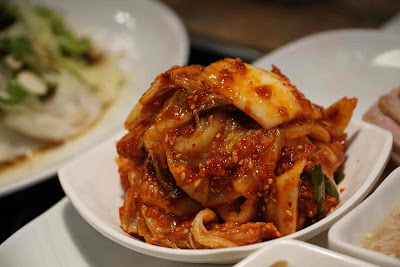What is Kimchi?
Kimchi is a traditional Korean dish or korean pickles. Which is made from fresh Napa cabbage. It is made by fermenting with salt, garlic, and hot sauce. The characteristics of Kimchi differ depending on the variety of Kimchi. The Varieties result from the raw materials used, processing methods, seasons, geographic area, and the functional properties of Kimchi.
Kimchi has been an important part of Korea's food for a long time(Since about 1000 years). The word Kimchi is derived from the ancient Korean word chimchae which means steeping vegetables in water. Koreans eat about 1600000 tons of Kimchi every year. Some people eat with maybe all food. Korea consumes 73,000 kg of Napa cabbage every year. The kimchi fermentation process is similar to cheese and yogurt and is great for our body's immune system. The process of making Kimchi starts with Napa cabbage and this is the same process as making a pickle.
Did you know? Kimchi has also set foot in space, meaning that the Korean astronaut also took Kimchi with him.
There are many types of Kimchi but most people prefer to eat poggy Kimchi.
Types of Kimchi
More than 200 kinds of Kimchi can be classified into two major groups.
[i] Ordinary Kimchi
[ii] Mul-Kimchi
[i] Ordinary Kimchi: These Kimchi made without added water. Ordinary Kimchi is subdivided into the below types.
[1] Baechu Kimchi (diced Chinese cabbage)
[2] Tongbaechu Kimchi (Whole Chinese cabbage)
[3] Yeolmoo Kimchi (Young oriental radish)
[4] Kakdugi (Cubed Radish Kimchi)
[ii] Mul-Kimchi: These Kimchi made by added water. Mul-Kimchi is subdivided by the below types.
[1] Baek Kimchi (Baechu Kimchi with water)
[2] Dongchimi (Whole radish Kimchi with water)
[3] Nabak Kimchi (Cut radish & Chinese cabbage)
The raw materials used for Kimchi preparation are divided into three groups which are major, sub-ingredients(spices), and optional ingredients. The optimum pH for the best taste of Kimchi is 4.2 - 4.5 with an optimum acidity of 0.6 - 0.8 % as lactic acid.
What does Kimchi taste like?
The best taste is attained after 2-3 days of fermentation at 20°c with 2-3% salt. Kimchi contains large amounts of live lactic acid bacteria(LAB). In this respect, Kimchi differs from western sauerkraut & Japanese asatsuke. The former is only acidic in taste (therefore lacking the complex taste of Kimchi) and is served warm, while the latter is not a fermented product & contains few live lactic acid bacteria(LAB).
Which types of microorganisms are in Kimchi?
During the past 50 years, many species of bacteria, yeast, and fungi have been isolated & reported from the Kimchi sample. The major microorganisms responsible for Kimchi fermentation are LAB and yeasts which are known to be responsible for the softening of Kimchi texture and off-flavor.
Factors affect Kimchi fermentation
(1) Salts and Salting conditions
(2) Temperature
(3) Raw materials
(4) Natural preservatives
(5) Starters
Why Kimchi is today Super-food?
Kimchi contains all the fiber and vitamins so it is also beneficial for our body. It also contains a lot of probiotics. This means that there are many beneficial bacteria in our bodies. So today Kimchi is considered in super-food.
How to make Kimchi?
Ingredients
- Water
- Salt
- Chinese/Napa cabbage
- Rice flour
- White radish
- Spring Onions
- Korean red chili powder
- Garlic paste
- Ginger paste
- Pureed shrimp [optional] If you are non-veg then must try it.
- Castor sugar [optional]
- Chili flex [optional]
Now we will see how to make Kimchi?
- First, cut the Chinese/Napa cabbage in the middle because the cut in the middle spreads the sauce evenly. Then it is washed & added salt. It is then kept in salted water for 24 hours.
- Now it is kept outside for 2 hours after being extracted from the saltwater so the water drains out of it. Its texture deteriorates if it is not pressed hard.
- Now we will make Kimchi sauce. Kimchi sauce is spicy, sour, and delicious. Its main ingredient is Korean radish which is less spicy & more sweet compared to red & normal type of white radish.
- So now the radish is crushed with the help of a machine.
- Chopped garlic, Korean red chili powder, chopped onions, pureed shrimp & pistachio ginger are mixed to make the sauce. But the sauce is not ready now add salt, sesame seeds, rice flour added. If you like more spicy food so you can also add chili flex so that the sauce becomes spicy & delicious.
- Now anchovy seaweed is added to it. Here seaweed is used as a food additive. So that the Kimchi stays fresh for a long time. Now, this mixture added in chopped radish and mix it. and the sauce will be ready.
- The sauce is now applied to all the strips of cabbage.
- Now it is kept in the fridge to start the fermentation process. It is kept for 1 week. But many people also like fresh Kimchi.

